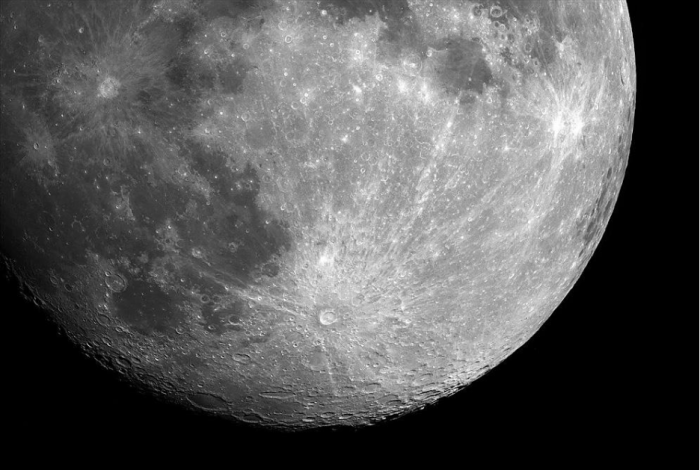
The surface of the Moon is pitted with a myriad of small impact craters (Figure 1).
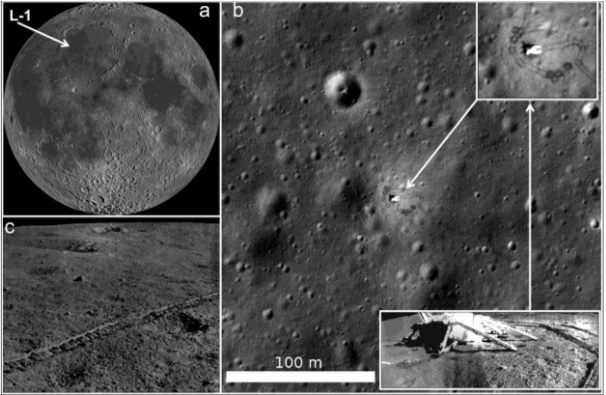
Figure 1.a) Near side of the Moon, global mosaic of LROC WAC images, arrow shows area of Lunokhod-1 studies; b) LROC NAC image of the landing site of Luna 17, which landed on the Moon Lunokhod-1, the upper inset shows blow-up part of the image with the lander seen in it, the lower inset is part of Lunokhod-1 TV panorama showing the Luna 17 lander; c) Typical landscape of the study area, width of Lunokhod-1 wheel track is 20 cm, part of Lunokhod-1 panorama. Image courtesy of Roscosmos/Russian Academy of Sciences and Courtesy of NASA/ASU for a & b.
An important characteristic of lunar surface geology is the duration of the lifetimes of small craters. This number was first estimated by Basilevsky (1976) based on an analysis of the Lunar Orbiter and Apollo high-resolution images of the Moon and isotopic measurements of ages of the surface exposition of rock fragments sampled by the Apollo astronauts (Figure 2 and 3).
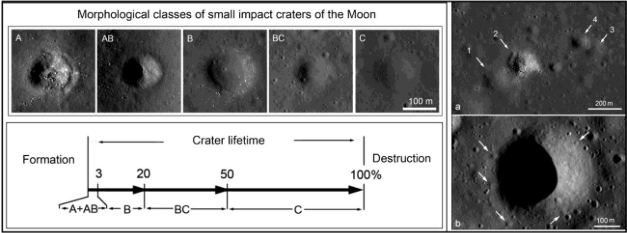
Figure 2. On the left is a morphological classification of small lunar craters showing their evolutionary changes from very prominent class A to subdued class C; on the right are examples of age relations of craters of various morphological prominence. Upper right – age relations of craters of approximately the same diameter: subdued craters 1 and 3 are cut by morphologically prominent craters 2 and 4. Upper left – age relations of craters of different size: on the rim of the large prominent crater are superposed small craters the most ancient of which, although being younger than the large crater, evolved into morphologically very subdued forms. Credit: Lunar Reconnaissance Orbiter Camera (courtesy NASA/ASU)
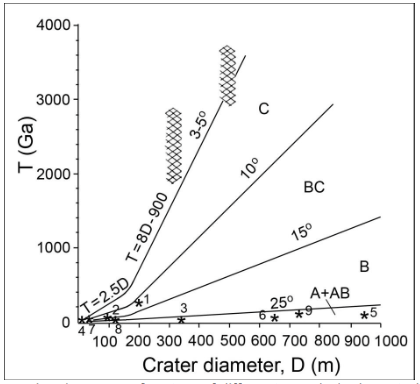
Figure 3. Diagram showing ages of craters of different morphologic maturity (from A to C) and different sizes. Numbered asterisks show age v.s. size positions of craters dated based on sampling by Apollo astronauts (adapted from Basilevsky, 1976).
It is seen from the diagram in Figure 3 that the number of isotopically-dated craters is rather small, and it is necessary to increase the reliability of the estimations presented in this Figure. In the discussed paper (Basilevsky et al., 2018), we considered so-called secondary craters, which are relatively small ones formed by impacts of ejecta from the larger “”primary” craters.
Ages of secondary craters are the same as ages of the corresponding primary craters, so if we know the age of some primary craters, we can use its secondaries of different diameters to study how their morphological prominence depends on their size. In the discussed paper, we considered secondary craters of primary crater Copernicus (age ~800 Ma) and Tycho (~100 Ma). The considered Copernicus secondaries are shown in Figure 4.
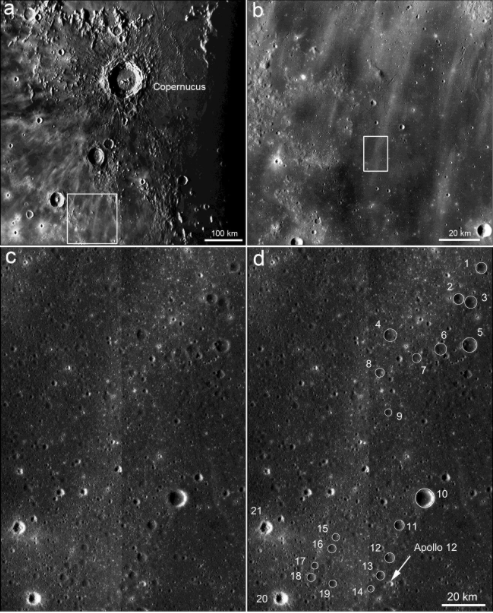
Figure 4. a) Crater Copernicus (D = 93 km) and system of its rays well seen in the SW part of the image, portion of image D21, Consolidated Lunar Atlas, https://www.lpi.usra.edu/resources/cla/; b) LROC WAC image mosaic of the area outlined in (a); white rectangle in (b) outlines area shown in Fig. 4c and d; c) and d) the studied craters in the mosaic of LROC NAC image pair M104662862, incidence angle 49.4o. Credit: Lunar Reconnaissance Orbiter Camera (courtesy NASA/ASU)
For the considered secondary craters of Copernigus and Tycho using the LROC-NAC images, researchers made digital terrain models, and then the depth/diameter ratios (d/D) and maximum steepness of crater inner slopes were determined for the ages between 100 and 800 Ma for craters ranging in diameter from 220 to 940 m. The resulting model diagram is presented in Figure 5 (that is Figure 11c of the discussed paper).
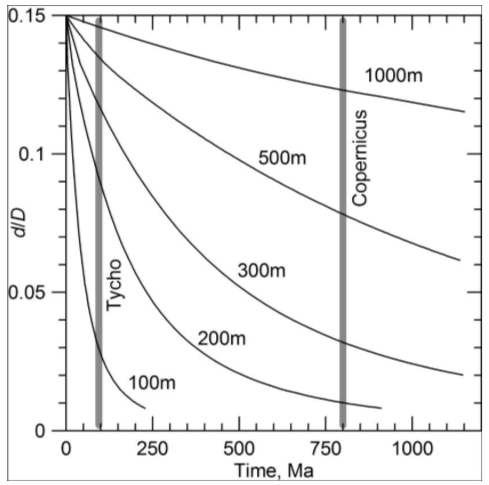
Figure 5. Evolution of depth-to-diameter ratio of modeled craters. Curves correspond to initial diameters of modeled craters of D0 ј 100 m, 200 m, 300 m, 500 m, and 1 km. Vertical lines show ages of craters Tycho and Copernicus. (Adapted from https://doi.org/10.1016/j.pss.2017.06.001)
These results allowed us to demonstrate that the diagram presented in Figure 3 is valid, although it does need further improvement.
These findings are described in the article entitled Morphometric studies of the Copernicus and Tycho secondary craters on the moon: Dependence of crater degradation rate on crater size, recently published in the journal Planetary and Space Science. This work was conducted by A.T. Basilevsky from the Vernadsky Institute and Moscow State University of Geodesy and Cartography, N.A. Kozlova, I.Yu. Zavyalov, and I.P. Karachevtseva from the Moscow State University of Geodesy and Cartography, and M.A. Kreslavsky from the University of California—Santa Cruz.









